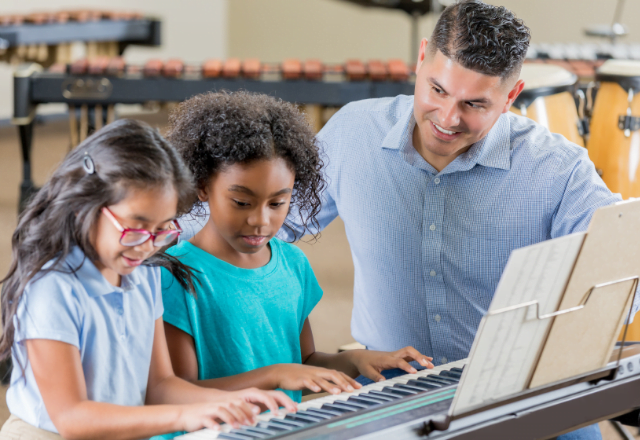When is the best time for piano students to start scales? Right away, when they reach intermediate level or somewhere in between? Or maybe we should be going by age rather than level?
We’ll unpack the ins and outs in this article and podcast so you can decide when to start scales with your piano student.

⬆️ Listen to the podcast above or keep on reading, whichever fits your style. ↙️
Most of us teach piano scales. But knowing when to teach them is a bit muddy. If you’ve been going back and forth on this, you’re not alone.
There are many questions to think about: When do we introduce technique? When are the hands developed enough? What about theory – is the student ready to learn notation and how a scale is formed?
I don’t have a standard time when all piano students start to work on scales. My approach is flexible and comes down to two questions:
- Is the student musically ready to start scales?
- Is the student technically ready to start scales?
As you may know if you’ve been a reader for a while now, my answer to black-and-white questions often lands in the grey. 😶🌫️
Let’s break it down into two manageable steps.
Step 1: Start with Scale Improvisation
I may be in the in-between when it comes to an exact timeline for starting scales. But what I’m much less ambiguous about is starting with improvisation first.
I prefer for students to improvise with any scale or mode at least a few times (and maybe dozens) before they meet it as an actual technical exercise. This makes scales feel relevant to them and allows them to understand the pattern on the piano before we add any kind of fingering pattern.
Go on a Circle of Fifths Odyssey
If you’re not sure how to approach improvising with scales, the Circle of Fifths Odyssey course will walk you through it. There are suggested teacher accompaniments and fully laid-out lesson plans so you can feel confident diving into new territory.
You can find the Circle of Fifths Odyssey course and resources inside the Vibrant Music Teaching membership. Not a member yet? Find out more and sign up here.
Students as young as 3 can work on scales to some degree if they improvise with them first because they play with one finger.
Use the Whole Arm
The advantage of playing scales in this way isn’t exclusive to preschoolers. By hopping from key to key students get comfortable using their arm weight to play and generally have better posture and supported fingertip joints.
Step 2: Assess Readiness for One-Octave Scales
Once a student has experienced scales through improvisation, the next step is to figure out if their body is ready for full scales yet.
For me, the most important indicator of this is legato technique. My students all begin by playing non-legato (more of that lovely arm weight we talked about above) and we introduce legato playing as they’re ready for it. This starts with two- or three-note slurs, and gradually builds to full phrases.
How’s the legato looking?
If we want students to play a traditional-looking scale (i.e. one-octave up and down with legato technique) we need to be sure their legato is solid and comfortable first.

The reason this is so crucial is because students who start scales before legato is fully established tend to play them with tension. They often drop their wrists to wrangle their fingers into submission or play with collapsing fingertip joints or pancake hands.
Take it from someone who learned this the hard way: Do not teach legato through scales. Develop your student’s legato technique first. Scales are just one more place to use this skill.
Keep it Relevant
Hang on, you haven’t stopped improvising, have you?
Don’t let go of the creativity and application just because they are working on the technical exercise. Once a scale has been learnt, continue to explore it through games, improvisation, composition, playing thirds or sixths apart, playing contrary motion, similar motion, staccato, soft, loud, hands far apart, high and low…the possibilities are endless!
Get creative and make sure to point out scales in pieces which students are learning so they connect the dots to written music, too.

If your students are ready to start one-octave scales but you’re not sure where to begin, check out the resources on my Music Theory hub page.
If your student isn’t ready to start scales…
Teaching young beginners has many unique challenges, but scales should not be one of them. The guidelines I’ve detailed above still stand.
However, you’ll probably find that most young students won’t pass the “legato test” in the same timeframe as an older child. Older adults, too, may take longer to get really comfortable with the legato technique.
This is totally normal and completely fine. Don’t rush your student’s development. Just sit back and enjoy the extra time you get to improvise until they’re ready.
When do you start scales with your students?
I’d love to hear your thoughts on this in the comments below. 🙂

I teach the c scale at the very first lesson – they love that there is something they can play right away!